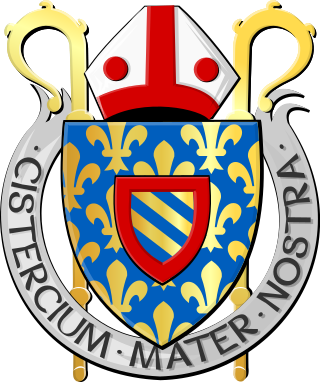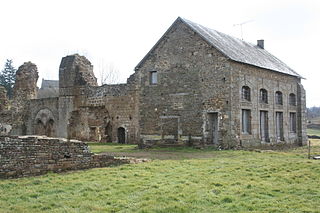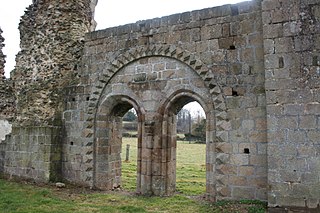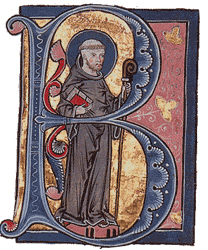History
The Order of Flora was founded in 1189 by the Abbot Joachim of Flora, by whom its constitutions were drawn up. Besides preserving a number of Cistercian observances, the founder added to the austerities of Cîteaux. The Florians went barefoot; their habits were white and very coarse. Their Breviary differed in the distribution of Offices from that of Cîteaux. The constitutions were approved by Pope Celestine III in 1196.
The order spread rapidly, soon numbering as many as thirty-five monasteries, but it seems not to have extended beyond Italy. In 1470 the regular abbots were replaced by commendatory abbots, but the abuses of this regime hastened the decline of the order.
In 1505, the Abbey of Flora and its affiliated monasteries were united to the Order of Cîteaux. In 1515, other Florian monasteries united themselves to the Grande Chartreuse (Carthusians) or to the Dominicans, and in 1570, after a century under the regime of commendatory abbots, not a single independent monastery remained, and the Order of Flora had ceased to exist. Under the Abbot of Flora were also four monasteries of religious women, who followed the Florian rule.

Cîteaux Abbey is a Catholic abbey located in Saint-Nicolas-lès-Cîteaux, south of Dijon, France. It is notable for being the original house of the Order of Cistercians. Today, it belongs to the Trappists.

The Cistercians, officially the Order of Cistercians, are a Catholic religious order of monks and nuns that branched off from the Benedictines and follow the Rule of Saint Benedict, as well as the contributions of the highly-influential Bernard of Clairvaux, known as the Latin Rule. They are also known as Bernardines, after Saint Bernard himself, or as White Monks, in reference to the colour of the "cuculla" or cowl worn by the Cistercians over their habits, as opposed to the black cowl worn by Benedictines.

The Trappists, officially known as the Order of Cistercians of the Strict Observance and originally named the Order of Reformed Cistercians of Our Lady of La Trappe, are a Catholic religious order of cloistered monastics that branched off from the Cistercians. They follow the Rule of Saint Benedict and have communities of both monks and nuns that are known as Trappists and Trappistines, respectively. They are named after La Trappe Abbey, the monastery from which the movement and religious order originated. The movement first began with the reforms that Abbot Armand Jean le Bouthillier de Rancé introduced in 1664, later leading to the creation of Trappist congregations, and eventually the formal constitution as a separate religious order in 1892.
A commendatory abbot is an ecclesiastic, or sometimes a layman, who holds an abbey in commendam, drawing its revenues but not exercising any authority over its inner monastic discipline. If a commendatory abbot is an ecclesiastic, however, he may have limited jurisdiction.

Stephen Harding was an English-born monk and abbot, who was one of the founders of the Cistercian Order. He is honored as a saint in the Catholic Church.

Alberic of Cîteaux, sometimes known as Aubrey of Cîteaux, was a French monk and abbot, one of the founders of the Cistercian Order. He is now honored as a saint.

Casamari Abbey is a Cistercian abbey in the Province of Frosinone, Lazio, Italy, about 10 kilometers east-south-east of Veroli.

The monastic Congregation of Savigny started in the abbey of Savigny, situated in northern France, on the confines of Normandy and Brittany, in the Diocese of Coutances. It originated in 1105 when Vitalis of Mortain established a hermitage in the forest at Savigny in France.

The Abbey of Fontenay is a former Cistercian abbey located in the commune of Marmagne, near Montbard, in the département of Côte-d'Or in France. It was founded by Saint Bernard of Clairvaux in 1118, and built in the Romanesque style. It is one of the oldest and most complete Cistercian abbeys in Europe, and became a UNESCO World Heritage Site in 1981. Of the original complex comprising church, dormitory, cloister, chapter house, caldarium, refectory, dovecote and forge, all remain intact except the refectory and are well maintained. The Abbey of Fontenay, along with other Cistercian abbeys, forms a connecting link between Romanesque and Gothic architecture.

Tre Fontane Abbey, or the Abbey of Saints Vincent and Anastasius, is a Roman Catholic abbey in Rome, held by monks of the Cistercian Order of the Strict Observance, better known as Trappists. It is known for raising the lambs whose wool is used to weave the pallia of new metropolitan archbishops. The pope blesses the lambs on the feast of Saint Agnes on January 21. The wool is prepared, and he gives the pallia to the new archbishops on the Solemnity of Saints Peter and Paul, the Holy Apostles.

Cistercian nuns are female members of the Cistercian Order, a religious order of the Catholic Church.

Savigny Abbey was a monastery near the village of Savigny-le-Vieux (Manche), in northern France. It was founded early in the 12th century. Initially it was the central house of the Congregation of Savigny, who were Benedictines; by 1150 it was Cistercian.

Grandselve Abbey was a Cistercian monastery in south-west France, at Bouillac, Tarn-et-Garonne. It was one of the most important Cistercian abbeys in the south of France.

Vaux-de-Cernay Abbey is a former Cistercian monastery in northern France (Île-de-France), situated in Cernay-la-Ville, in the Diocese of Versailles, Yvelines. The abbey was abandoned during the French Revolution and fell into partial ruin. Most of the buildings, except for the church, were restored in the late 19th century by Charlotte de Rothschild, and the property is now a hotel.

The Feuillants were a Catholic congregation originating in the 1570s as a reform group within the Cistercians in its namesake Les Feuillants Abbey in France, which declared itself an independent order.

Preuilly Abbey was a Cistercian monastery in Égligny in the Seine-et-Marne department, France. It was located about 21 kilometres south-west of Provins and 15 kilometres east of Montereau-Fault-Yonne.

Anglican Cistercians are members of the Anglican Communion who live a common life together according to the Cistercian tradition. This tradition is usually dated to 1098 in origin. The term Cistercian is derived from Cistercium, the Latin name for the village of Cîteaux, near Dijon in eastern France. It was in this village that a group of Benedictine monks from the monastery of Molesme founded Cîteaux Abbey in 1098, with the goal of following more closely the Rule of Saint Benedict. Monks following this rule are known as Benedictine, and were at that time the dominant force in Christian monasticism. The monks of Cîteaux Abbey effectively founded a new order, but one that remains closely associated with the Benedictine Order. As a mark of their distinctive charism and rule, Cistercian monks have long worn white habits to distinguish themselves from Benedictine monks who wear black habits. Within Anglicanism there has historically been less interest in the Cistercian Order than certain other monastic Rules, although Cistercian life has been represented continuously in the Church of England since at least 1966.

Igny Abbey or Val d'Igny Abbey is a Cistercian abbey located in Arcis-le-Ponsart, Marne, France. It was founded in 1128 for Cistercian monks, dissolved in 1791 during the French Revolution, re-established in 1876 for Trappist monks, destroyed in 1918, reopened in 1929 for Trappist nuns and modernised in 2008–12 to accommodate three or four pre-existing communities.

Carta Caritatis is the constitution of the Cistercian Order. The document, approbated in 1119 by Pope Calixtus II, regulates relations among the Cistercian abbeys. The text was continually revised and adapted until 1155. In terms of canon law, the Carta Caritatis is a document of unprecedented significance, since it introduced the systematic regulations that made a group of monks at Cîteaux into the first religious order in Church history. It is held in high esteem as a legal monument of great influence.

Claude Vaussin was abbot of Cîteaux from 1643/1645 until 1670, and as such, Abbot General of the Cistercian Order.


















